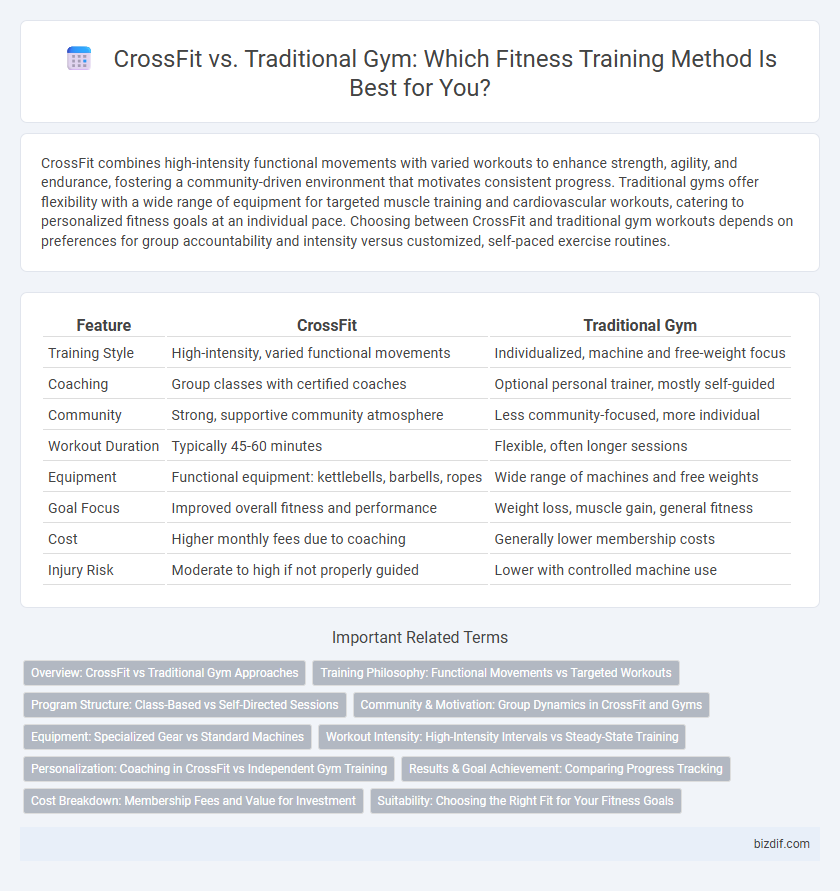CrossFit combines high-intensity functional movements with varied workouts to enhance strength, agility, and endurance, fostering a community-driven environment that motivates consistent progress. Traditional gyms offer flexibility with a wide range of equipment for targeted muscle training and cardiovascular workouts, catering to personalized fitness goals at an individual pace. Choosing between CrossFit and traditional gym workouts depends on preferences for group accountability and intensity versus customized, self-paced exercise routines.
Table of Comparison
| Feature | CrossFit | Traditional Gym |
|---|---|---|
| Training Style | High-intensity, varied functional movements | Individualized, machine and free-weight focus |
| Coaching | Group classes with certified coaches | Optional personal trainer, mostly self-guided |
| Community | Strong, supportive community atmosphere | Less community-focused, more individual |
| Workout Duration | Typically 45-60 minutes | Flexible, often longer sessions |
| Equipment | Functional equipment: kettlebells, barbells, ropes | Wide range of machines and free weights |
| Goal Focus | Improved overall fitness and performance | Weight loss, muscle gain, general fitness |
| Cost | Higher monthly fees due to coaching | Generally lower membership costs |
| Injury Risk | Moderate to high if not properly guided | Lower with controlled machine use |
Overview: CrossFit vs Traditional Gym Approaches
CrossFit emphasizes high-intensity functional movements performed in varied workouts to develop strength, endurance, and flexibility simultaneously. Traditional gyms typically offer isolated strength training and cardiovascular equipment designed for targeted muscle development and steady-state cardio sessions. Both approaches cater to different fitness goals, with CrossFit fostering community-driven, performance-based training and traditional gyms supporting customizable, individual routines.
Training Philosophy: Functional Movements vs Targeted Workouts
CrossFit emphasizes functional movements that mimic everyday activities, promoting overall strength, endurance, and mobility through varied, high-intensity workouts. Traditional gyms focus on targeted workouts that isolate specific muscle groups, allowing for concentrated muscle development and incremental strength gains. The CrossFit philosophy encourages holistic fitness and adaptability, while traditional training prioritizes muscle hypertrophy and specific fitness goals.
Program Structure: Class-Based vs Self-Directed Sessions
CrossFit programs emphasize structured, class-based workouts led by certified coaches, fostering community engagement and ensuring proper technique. Traditional gyms typically offer self-directed sessions where individuals customize routines, promoting flexibility but requiring more personal discipline. The class-based model enhances motivation and accountability, while self-directed training allows tailored pacing and exercise selection.
Community & Motivation: Group Dynamics in CrossFit and Gyms
CrossFit fosters a strong sense of community through its group workouts and shared fitness goals, enhancing motivation and accountability among participants. Traditional gyms often offer more individualized routines, which can lack the social support and collective energy found in CrossFit classes. The group dynamics in CrossFit create an environment that encourages pushing limits and celebrating achievements together, boosting overall engagement and performance.
Equipment: Specialized Gear vs Standard Machines
CrossFit training utilizes specialized equipment such as kettlebells, plyometric boxes, Olympic barbells, and medicine balls designed to enhance functional strength and high-intensity workouts. Traditional gyms typically feature standard machines like treadmills, elliptical trainers, and weight stacks that target isolated muscle groups with controlled movements. The choice between CrossFit's versatile gear and traditional gym machines significantly impacts workout variety, intensity, and functional fitness development.
Workout Intensity: High-Intensity Intervals vs Steady-State Training
CrossFit training emphasizes high-intensity interval workouts that combine functional movements performed at maximum effort in short bursts, boosting cardiovascular capacity and muscular endurance efficiently. Traditional gym routines often rely on steady-state training, involving prolonged, moderate-intensity exercises aimed at fat burning and aerobic conditioning. High-intensity intervals in CrossFit accelerate metabolism and promote faster strength gains, while steady-state workouts generally support sustained energy output and recovery.
Personalization: Coaching in CrossFit vs Independent Gym Training
CrossFit offers personalized coaching that adapts workouts to individual skill levels, promoting continuous improvement through real-time feedback, unlike traditional gym training where guidance is often self-directed or limited to occasional trainers. Coaches in CrossFit monitor form, provide motivation, and tailor programming to address specific fitness goals or limitations. Independent gym training typically lacks this consistent personalized supervision, making it challenging to optimize techniques and prevent injuries without expert input.
Results & Goal Achievement: Comparing Progress Tracking
CrossFit utilizes measurable benchmarks like WODs (Workouts of the Day) and scaling options to optimize progress tracking, enabling precise evaluation of strength, endurance, and skill gains. Traditional gyms often rely on self-monitored metrics such as weight lifted and cardio duration, which can lack standardization and consistency in goal assessment. CrossFit's structured performance tracking fosters accountability and faster identification of plateaus, promoting tailored adjustments that enhance goal achievement efficiency.
Cost Breakdown: Membership Fees and Value for Investment
CrossFit membership fees typically range from $150 to $300 per month, reflecting the cost of specialized coaching and group classes, while traditional gym memberships average $30 to $60 monthly, offering access to machines and open gym time. The higher price of CrossFit often includes personalized training, community support, and structured programming, enhancing value for those seeking guided fitness improvement. Traditional gyms may provide cost-effective options for independent exercisers but might lack the specialized coaching and social accountability found in CrossFit environments.
Suitability: Choosing the Right Fit for Your Fitness Goals
CrossFit offers high-intensity, functional movements ideal for those seeking varied workouts that build overall strength, endurance, and agility, making it suitable for individuals targeting competitive fitness or rapid performance gains. Traditional gym routines provide customizable strength training and cardio options, better fitting those who prefer controlled environments, specific muscle group focus, or gradual progress. Evaluating personal goals such as weight loss, muscle building, or endurance enhancement assists in selecting the appropriate training style tailored to individual fitness aspirations.
CrossFit vs Traditional Gym Infographic

 bizdif.com
bizdif.com